More than 130 lavish resorts, each with its own charm, make up this enchanting haven. Almost everywhere in the Maldives you'll find a secluded beach with the most beautiful pearly white sand and contrasting crystal-clear waters.
The islands of the Maldives are divided into 26 groups, called 'atolls' (which, mind you, can have more than one name) and the atolls themselves are grouped by cardinal point and characteristics. The northern atolls? The best underwater action - even eating underwater is sensational. The Malé atolls? Watersports and boat trips galore. The southern atolls? No crowds and limitless spectacular beauty. The Maldives are a perfect dream, with something for everyone.
Beaches in the Maldives
The beaches alone attract over a million visitors a year to this remote Indian Ocean paradise - luckily there's something for everyone! Almost every one of the country's 1,192 islands has the white sands and sparkling lagoons you see in travel magazines. Whether you're looking for seashells, drying off after a snorkelling session or indulging in existential contemplation, here are some of the most famous sands.
Best beaches in the Maldives
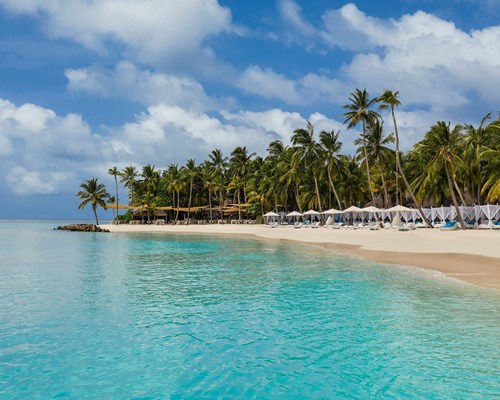
Reethi Rah Beach, North Malé
Twelve beautiful white beaches surrounded by fluorescent bays and incredible sunsets can be found at Reethi Rah. Pristine and pure, you'll find this restful wonderland at the One & Only Reethi Rah Resort, in the North Malé Atoll.
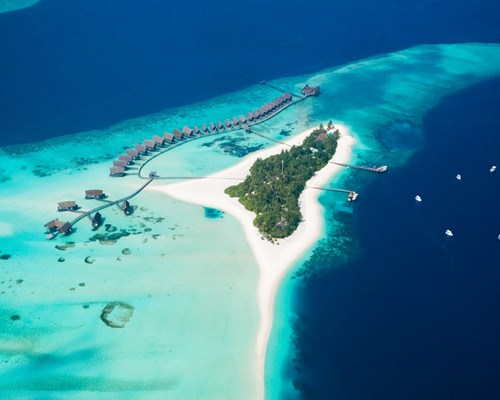
COMO Cocoa Island Beach, South Malé
Encircled by jewel-blue lagoons, this shallow island captures the true quintessence of paradise. Whether you're walking barefoot on dreamy sands, swimming in the warm ocean or simply getting hypnotised by the breathtaking horizon, Makunufushi Island allows you to relax and disconnect from it all. You can enjoy this private glam paradise owned by a luxury resort known as COMO Cocoa Island resort in the South Malé Atoll.
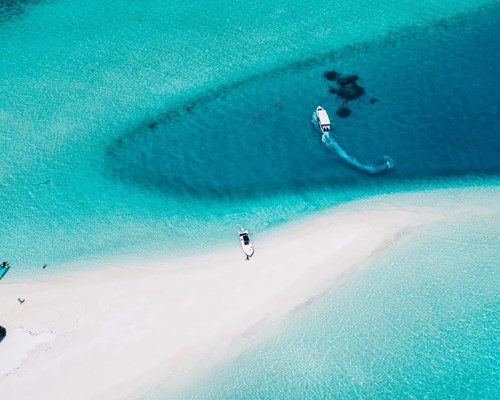
Finolhu beach, Kanifushi
This lush island in the Baa Atoll is quite unique because it just keeps going and going and going. A mile-long strip of sand juts out from the beach, connecting it with three other uninhabited islands. Lapped on either side by turquoise waters, you won’t find another walk like it. That is, assuming you can tear yourself away from the Finolhu lagoon − spotless water (no coral to catch your toes on), a backdrop of giant palms and a lagoon the width of 10 Olympic pools. Stay at the 5-star Seaside Finolhu to enjoy this magnificent beach.
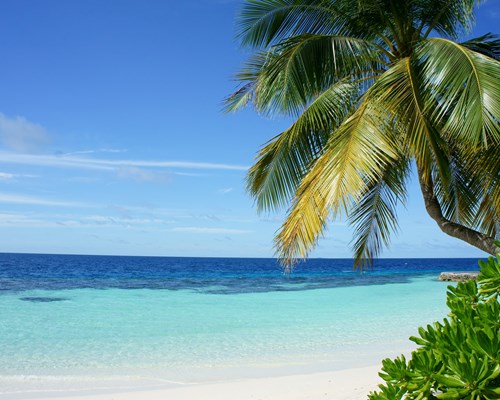
White Sandy Beach, Fulhadhoo, Baa Atoll
It’s hard to imagine this is one of the most hyped Maldivian beaches when you’re on it as there’s often not another soul on this hypnotic stretch of sand. Thanks to infrequent visitors, fish have no fear of humans and the coral is gloriously intact. Come on snorkelling trips from resorts in the Baa Atoll and you can check out 15 surrounding islets. If you venture away from the beach just be sure to respect the no-bikinis off the beach policy.
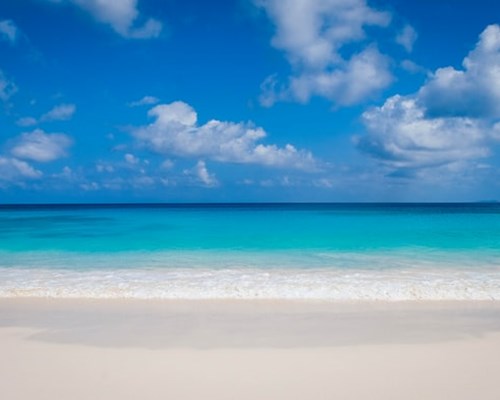
Hulhumalé Beach, North Malé
Hulhumale is a man-made island in the North Malé atoll. It’s not the place to spend a week, but if your flights keep you in Malé overnight, we’d take Hulhumalé Beach over an airport hotel. The beaches are made up of perfect white sand and the water here is as turquoise as it gets. You’ll find plenty of restaurants along the promenade with authentic Maldivian cuisine.
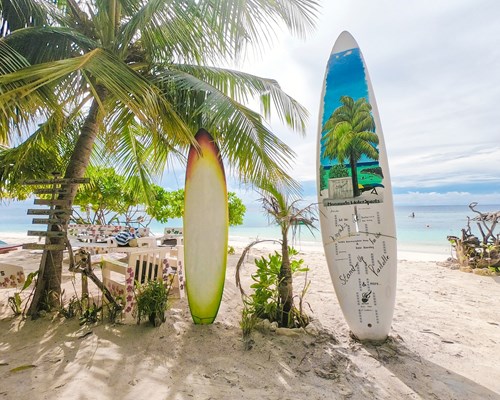
Bikini Beach, Maafushi
Maafushi is the most popular island in South Malé, with a blossoming guesthouse scene and good vibes aplenty. There are four main beaches on the island - Bikini Beach, Public Beach, Water Sports Beach and Coral Beach. Lined with coconut palms and bustling with cosy hotel bars, Bikini Beach is possibly the most down-to-earth beach in the Maldives. This is one of the few public beaches in the country. Kick back and let the sound of calm waters unwind your soul and revive yourself with a sun-kissed glow.
Maldives geography
Maldives history
Wildlife in the Maldives
Activities in the Maldives
Watersports
Diving in the Maldives
Each and every resort in the Maldives caters for divers and snorkellers. And you’ll find many organise daily excursions to the best local dive sites and snorkelling spots (often chucking in snorkelling equipment free). If there’s not much of a house reef around your resort, you’ll find (or can hire) marine biologists who can provide information on the types of fish and coral you'll encounter. The country’s best underwater topography has been lavished on the atolls of North Malé, Ari, Lhaviyani, Laamu, and Meemu, and channels here offer drift dives of all shapes and sizes for both new and experienced divers. North Malé’s Banana Reef is one of the most famous, a breathtaking medley of steep drop-offs, overhangs and dramatic rocks blanketed in coral, but with the crowds to match its super-status. Elsewhere, submerged islands, called “thilas” are a Maldives hallmark, covered in coral and full of fish. South Ari has some of the best, and spots like Fish Head, Maaya Thila and Kudaraah Thila (experts only) in a marine protected area draw aquatic creatures in their thousands.
Really though, its thriving manta ray and whale shark (the chunky, toothless and friendly variety) populations are the reason the Maldives is considered a top diving destination. With the right information, you’re all but guaranteed to meet some of these graceful giants. The Ari and Baa atolls are their favourite hangouts, but all atolls have seen manta and whale shark activity. Many resorts offer “on-call” services to alert you when mantas and sharks are in the area.
If you’re a first-time diver, this is one of the best places to learn and you’ll find PADI-certified schools left, right and centre to get you up, running and licensed. Typically, beginners are taken shore diving in shallow house reefs, a stress-free induction that lets you meet colourful fish and coral from day one.
Surfing in the Maldives
Silky barrels and endless, mile-long waves are the specialities in these warm, turquoise waters and the fact this country is split into 1192 islands guarantees plenty of breaks. Most Maldivian waves, reaching about head height, can't be considered crazy powerful, but there are plenty of them and several wonderful exceptions to the middling height rule. The Malé atolls are home to the most famous, like Chickens, a left-hander which consistently breaches 10ft and rides for over 500m. Protected from the southerly winds that affect other breaks, Sultans and Cokes are the 8ft waves to ride when the swell is having an off day. It’s still possible to beat the crowds on the Malé waves by finding resorts with exclusive access to certain breaks. Hudhuranfushi has dibs on Lohis, an ultra-consistent reef break considered the best left in the Maldives.
Surf schools are most numerous in the Malé atolls, and if you’re looking to learn, the Four Seasons Kudaa Hura, Hudhuranfushi and Anantara have all been praised for their tip-top schools. But many resorts Maldives-wide offer boards for hire, meaning intermediates who can handle themselves on a board will have the most options.
As the Malé waves heat up, the southern atolls of Laamu and Thaa have become the new frontier in Maldives surfing, containing over a dozen practically unknown waves with NO crowd factor. We found schools (and boards) at Niyama in Dhaalu, COMO in Thaa and the most impressive at the Six Senses Laamu, to teach you in these blissful conditions.
The surf season in the Maldives depends on your atolls but expect most of the archipelago to be good for surfing from March till October. For super clean waves and unbeatable weather, generally, arriving before early May is a good idea. That said, swells are consistent through to June and great in November. Just expect more extreme swells from July to September.
Windsurfing & kitesurfing in the Maldives
With warm waters, reliable winds and large, shallow lagoons around most islands, the Maldives is an incubator for beginner wind and kitesurfers, and schools for these sports have been cropping up in recent years. The first kitesurfing school in the country was formed at Olhuveli, where VDWS-certified instructors can get you up and running in the ideal sandy-bottomed house lagoon. When you’ve mastered the art of getting (and staying) on your board, famed wave Guraidhoo is just 10 minutes away by speedboat for the next rung up the surfing ladder. On the last count, other resorts offering kite instruction included the Four Seasons Landaa Giravaruu and the Sheraton.
For windsurfers specifically, the gong for the best and biggest range of equipment has for many years gone to the Anantara in South Malé, whose Anantara Dhigu and Anantara Veli resorts both have huge lagoons. That said, most resort watersports centres offer windsurfing equipment, sometimes free of charge.
Surprisingly though, the most developed and popular forms of surfing here are those you’ve probably never heard of. Wakeskating, kiteboarding, mono-jet skiing, flyboarding (skateboards with jet packs attached), each year, watersports centres seem to dream up new ways for guests to glide, charge or propel themselves through the water. Inflatables are a particular hit with teenaged thrill-seekers, where speedboats tow banana boats, tubes and rings at super speeds. Helping you document these moments, some resorts rent out GoPros or can even take drone shots of you in action.
Sailing in the Maldives
While getting anywhere beyond the edges of your island involves a scenic boat ride, trust us, these are over all too quickly. Luckily, there are also lots of boating options that focus on the journey over the destination. Dhonis, the most popular, are the name of the traditional Maldivian fishing boats with distinctive curved prows, often hand-crafted from coconut wood.
The only limit to what you can do on a Dhoni is your imagination. Resorts offer everything from romantic dinner cruises for two, rustic fish trips with hand lines, dolphin-spotting tours at dusk and nightly rides through the ether (plus are always open to further suggestions). If you do only one, night sailing is perhaps the most unforgettable. As the Maldives is so close to the equator, the moon shines at a thousand kilowatts and stars stand out with gobsmacking clarity – you get home feeling like you’ve had a day-long massage.
If the prospect of charting your own course through these islands appeals, many resorts offer fleets of sailboats, such as K1 and K2 Topcats and Bravo Mini Cats, which you can hire with or without a skipper. Even first-time sailors shouldn’t have much trouble using these simple crafts without assistance, but resorts have also previously offered catamaran lessons to help you get to grips with the basics and learn how to balance and turn. Super popular jet ski tours are another great way of covering the ground, which kids from 10 years and up can usually join.
Fishing in the Maldives
Home to some of the fishiest waters on earth, you can bet just about every resort in the Maldives will arrange fishing trips, the majority conducted on traditional “dhoni” boats at dusk using hand lines. You’ll have to put some distance between yourself and your island before you can catch. Resorts are pretty keen to protect fish in their house reefs and most prohibit shore fishing (or fishing within 1 km of the shore) to make sure local fish populations thrive.
While most people think of fishing as a relaxing pastime, with the right equipment and the right rod and reel, it can easily be likened to an extreme sport. For fishers who mean business, many resorts offer big-game expeditions through dozens of available charters fitted with “fighting chairs”. Most depart from the harbour in Malé, so you’ll have the most options staying in the Malé atolls. From December to March, during the dry season, there are some serious beasts for the taking. Some book week-long “liveaboard” expeditions just for a chance to reel in the huge giant trevally (“GT”), and a bounty of marlin, sailfish, as well as tuna, dorado, and wahoo. Sure, big-game trips can be pricey, typically charging by half-day or full-day, but splitting costs between mates (or new mates) easily make things affordable.
Canoeing & kayaking in the Maldives
Solo or tandem, glass-bottomed or brightly coloured, guided tour or solo exploration, there’s a whole raft (haha) of options when it comes to kayaking here and when you’ve exhausted them all, you'll find plenty more to do with a paddle besides. Stand-up paddleboarding (“SUP”) is said to be the world’s fastest-growing sport and is a fantastic way here to peer into the depths of a house reef while unwittingly getting in a core workout.
If paddling starts feeling too slow-paced, many resorts offer alternatives with a thrill factor, like riding to distant islands on jetskis (some offer tours to all 10 years and above) or “sea bobbing”, being pulled through the water like a submarine by a motorised “bob”.
Land activities
Golf in the Maldives
It’s going to be difficult to putt your way to golfing glory in the Maldives, where just a handful of recreational courses are joined by the odd driving range. In the very south, the Shangri-La Villingili has one of the most extensive courses, a nine-holer with distracting ocean views throughout a 1km circuit. In Malé, the Reethi Rah has previously offered “lagoon chipping”, which involves driving golf balls into the ocean. Failing those, the golf simulators previously spotted at the Niyama, St Regis and Six Senses Laamu can offer a very detailed analysis of your swing.
Cycling in the Maldives
One of the Maldives’ longest roads, the Gan-Hithadhoo causeway, stretches for 14 km connecting the islands of Gan, Feydhoo, Maradhoo and Hithadhoo and you can rent bikes to cycle this coastal route from the Feydhoo harbour in Gan (last time we checked, Equator Village resort here was a good spot for rentals). Guests at the Shangri La Villingili have also previously been allowed to bring bikes across to the causeway by boat from the resort, but expect the basketed, traditional kind, rather than the latest offering from Giant. Fruit and coconut vendors line this causeway and you can witness interesting cottages made of coral, all in all, offering a rather pleasant day out. Southern Laamu atoll is home to another long scenic road, from which you can visit Buddhist ruins and charming fishing villages.
However, if you’re not staying in or near the Addu or Laamu atolls, pedalling around your island will probably have to content you (and content you it will). Nature trails make for interesting inland exploration on many islands while cycling along the beach is a great way to get from beach to bar in a cooling breeze. Many resorts offer guests bikes for rent, if not for free.
Walking & hiking in the Maldives
It feels like even the clocks tick slower in the Maldives and exploration on foot takes the same slow pace. You don’t walk but stroll along Maldivian beaches and many resorts offer maps of nature trails where you can meet resident turtles, birds and crabs. When no resort island measures more than 4 km in circumference, you won’t develop blisters during your stay, but you can still get plenty of mileage out of a stretch of sand– hunting for shells and coral that’s washed up overnight or walking off some very satisfying dinners beneath some dazzling clear stars.
For the sheer variety of routes, the Malé atolls have most in the way of day trips; visits to local fishing villages or historical tours of the capital are a good way to stretch the legs while learning about the culture of this vibrant country. That said, almost every atoll has a capital with a fishing community and market where you can get out and about, buy local crafts and find fresh fruits. Resorts are usually more than happy to arrange boats, guides and picnics to go with you.




